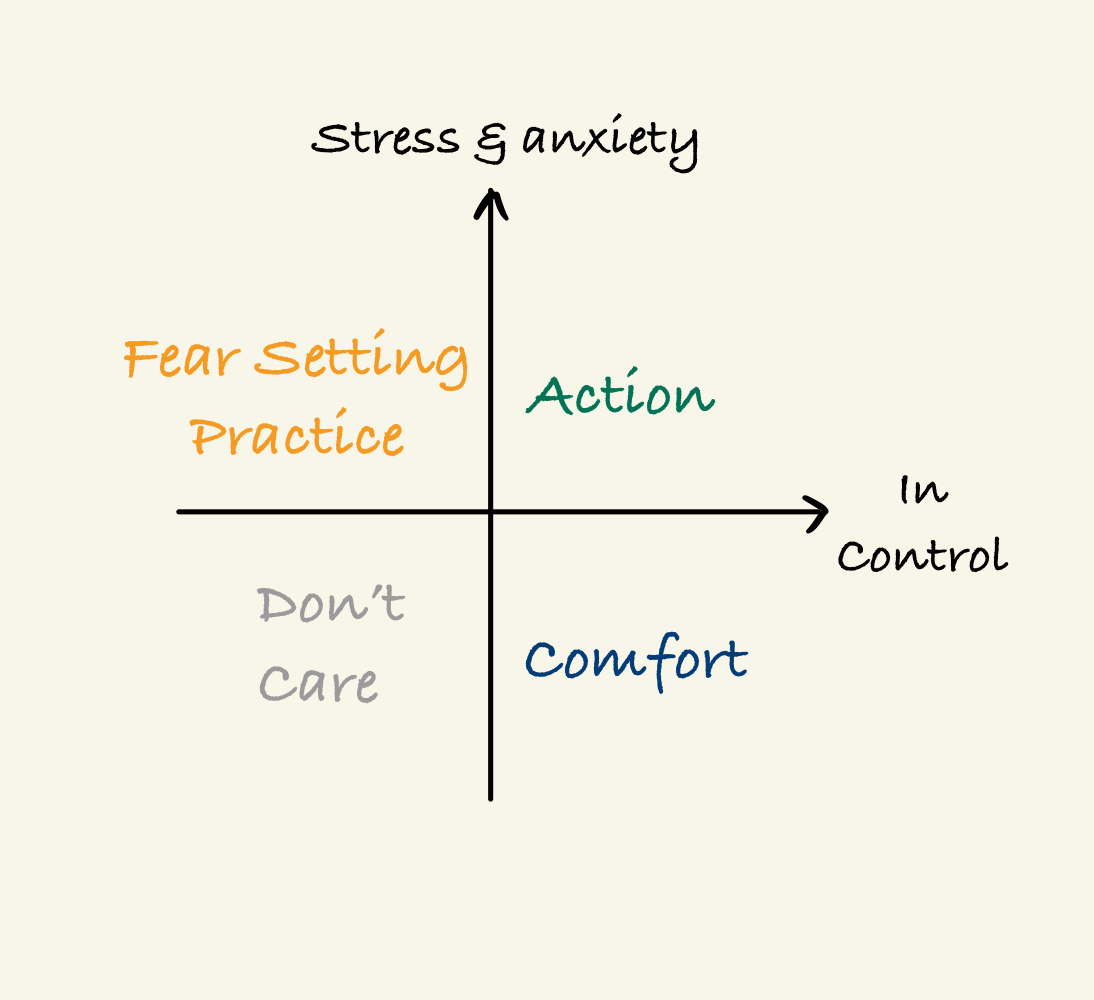
I once visited Jikoji Zen Center for their Sunday guided meditation program. Judging from all the Patagonia and Lululemon, most participants were white-collar professionals from the Bay Area—people working high-paying jobs in a fast-paced environment.
During the Q&A session after the silent practice, the focus shifted towards stress, anxiety, and fear. The recurring theme became: “I’ve been following your guided meditation, but I still feel anxious. It’s not working.” It is not surprising, as I am and have been one of them for a long time.
Meditation helps; I practice it often myself. But it’s not a cure-all. I believe there’s a better framework for addressing stress and anxiety.
A Framework for Stress and Anxiety
Breaking down stress and anxiety often involves cross-referencing what’s in our control and what’s not. This leads to the classic 2x2 quadrant:

It is our classical comfort zone when we don't stress about things in our control. However, plenty of things stress us, although we can do something about it.
In Control, But Stressed
Jeff Bezos summarized stress management well in this video:
"Stress primarily comes from not taking action over something that you can have some control over. So, if I find that some particular thing is causing me to have stress, that's a warning flag for me that something is bothering me, and I haven't yet taken any action on it. Stress comes from ignoring things that you shouldn't be ignoring."
We’re not all Jeff Bezos, but the core idea holds true.
Anxiety often lingers even when we have control over a situation—like preparing for a project or meeting. The key is to take action. Writing down an agenda or doing a dry run can transform anxiety into clarity. For example:
- Before a big project, write down detailed plans.
- Before a meeting, draft an agenda and anticipate questions.
- Before reaching out, practice and consider the other person’s perspective.
Inaction often stems from self-doubt or imposter syndrome. It can feel like we’re not capable of being in control, but the best way to push through is to act as if it’s easy. Take the first step and keep moving forward, even if it feels uncertain.
What if the agenda you wrote is the exact roadmap to a successful project? What if the solution in your mind is already the right one? Trust in what you can control, and approach the unknown with confidence that everything you don’t yet know is learnable and manageable. Because deep down we all know the only way to learn and manage is to do it anyway.
Not in Control
When something is outside your control, establish boundaries: Is there anything else I can do? Once you’ve acted, let go of the outcome.
For overwhelming situations, try fear-setting, as Tim Ferriss explains in his TED Talk:
- Identify the fear.
- Define the worst-case scenario.
- Calculate the cost of inaction.
- Plan to mitigate risks.
I practice fear-setting in many cases. It’s a great thinking exercise, but what’s more valuable is applying it in low-risk areas where I have control.
I used to fear or get stressed about rejection, and have gotten much better by practicing in settings where the stakes are low, like asking for a discount at Starbucks. I often ask ridiculous things like, “Do you have any discounts you can apply?” or “Can you apply your employee discount to my order?”
My friends’ reactions usually range from cringe to disbelief. I know 99% of the time the answer is no, and it doesn't matter to a $5 latte. But it makes me more comfortable hearing it. Life goes on, and I gain confidence for bigger asks—like negotiating deals or requesting promotions.
Genetic hair loss runs in my family, and the anxiety weighed on me in my mid-20s. During the pandemic, I decided to confront it 'head-on' by shaving my head.
The result? My head became so bald that it was reflective. I had great laughs with friends and family over video calls. No one cared—and neither did I. What’s the worst that can happen if I lose all my hair? Now I know, and I have nothing to feel anxious about. Facing the fear in a controlled way stripped it of its power.
Growth and Discomfort
Not all anxiety can be resolved through practice or frameworks. In those moments, I remind myself: discomfort signals growth. It’s an uphill battle but one worth pushing through.
Growth is always uncomfortable, but it doesn’t have to be miserable.